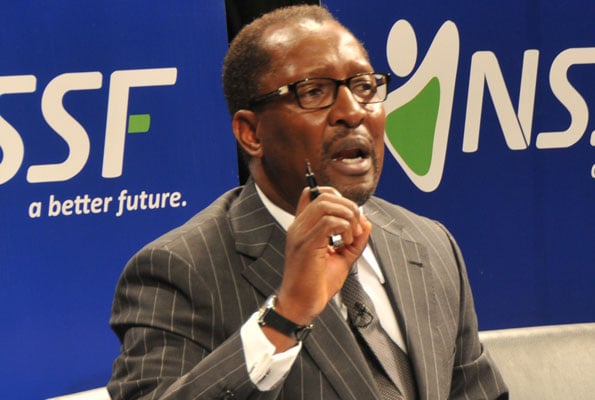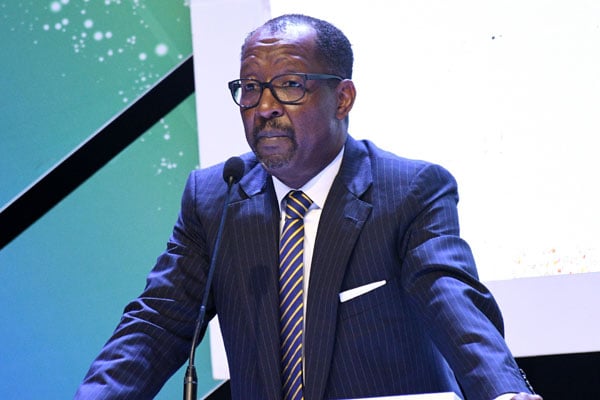Technology boosts NSSF’s digital footprint

The NSSF Smart Card is a solution for remitting contributions and also payout for the qualifying members. PHOTO/Edgar R. Batte
What you need to know:
- Re-engineering the Fund's business processes was key to delivering a new and exciting customer experience.
- The target was to get have at least 75% of all the Fund’s business processes automated by 2019/20 and 80 percent by 2024/25.
Great things happen when technology mixes with vision and good governance.
While the role of good governance, both at the board and management level as well as the subsequent great vision and strategic execution that was ushered in after 2009/10 has been extensively discussed, there has not been as much attention put on the role of technology and digitalisation in transforming NSSF from a government parastal to one of the most trusted and respected government institutions in the region.
It all started with the Fund’s 10-year strategic plan in 2015, which sought to transform NSSF into a “social security provider of choice” and a “relevant partner to our customers through continuous innovation in social security.”
One of the key strands of the strategy was leveraging technology to enable faster and more efficient service delivery.
“We wanted to be a model of operational excellence in Africa. But this couldn’t happen when people were spending time in long queues for services, taking more than 105 days to have their claims settled,” Byarugaba recalls.
“We did a customer survey around 2014 and our stakeholders told us that while reasonable and consistent returns were a must, they also wanted quick accessibility and timely customer service. Therefore, excellence in our service delivery channels and customer relationship was going to be very key to our success,” he says.
At the time, only 55% of the Fund’s core business processes were automated, with a lot of bureaucratic delays, worsened by the manual movement of files and cheques. An internal review also showed that as a result, inefficient and manual processes, as well as procurement delays, lead to lost time and cost members a lot of value in missed investment and commercial opportunities.
“Re-engineering our business processes was key to delivering a new and exciting customer experience. The target was to get have at least 75% of all the Fund’s business processes automated by 2019/20 and 80 percent by 2024/25,” he says.
“Technology and digitisation not only improves the customer experience but also improves data quality which enables timely and accurate decision-making across the business,” Byarugaba adds.
Automated customer experience
The very first technology initiative was the NSSFGO service platform. The thinking behind NSSFGO was that customers should be able to self-serve on the go, 24/7.
“Originally, members would physically visit NSSF branches to access all services including mere account balance inquiries. But with a growing membership, this was unsustainable and unnecessary. With NSSFGo, our members could, using an App, our revamped website and by dialing *254# on their mobile phones, including for non-smartphones, self-serve on a variety of services.
Over time, the platform has been revamped and handles voluntary contributions payments via Airtel and MTN Mobile Money, benefits claim applications, balance inquiries and e-statements, member self-registration and contacts updates as well get direct access to their relationship manager,” Byarugaba says.
Currently, there are 91,165 active users of the App alone.
To complement the App, the NSSF website was enriched with self-services for both employees and employers. On the employer side, these services include company registrations, clearance certificates, and contributions payments. On the employee side, self-services include contributions remittances, benefits claim, member registration, balance and statement inquiry as well as a whistleblower platform to report defaulting employers.
“The increased adoption of self-service channels for social security contributions payment, registration (both employers and employees), savings tracking, benefits application & tracking, biodata update, – for convenience, efficiency, and greater access. Online employer registrations have increased from almost none in 2011 to 2,744 employers while online employee registrations increased from almost none in 2011 to 128,239 members. The e-channels/walk-in ratio has improved from 38:62 in 2011 to 93:7 in 2021/22,” explains Byarugaba.
To enable employers to make payments to the Fund, NSSF invested in Straight Through Process- an e-Collections platform. Unveiled in February 2016, this allowed employers to directly pay to NSSF’s bank accounts.
NSSF Smart Card
Digitally future-proofing the Fund with the NSSF Smart Card, a new digital mid-term payment tool and a robust pensions system.
The Fund is on course to meet all its 2024/25 targets, but this is no reason for the management to bask in the glory of yesterday’s achievements. Byarugaba says the Fund must continuously reinvent itself to meet the ever-growing needs of customers.
The Fund, according to, Byarugaba, the managing director, since 2009, will also not only hit its financial targets, which also include compliance and keeping member benefits above inflation; it should also hit its other non-financial targets on customer and staff satisfaction.
“When we assumed leadership of the Fund, customer satisfaction was 41% and staff satisfaction a trifle 48%. Benefits contribution compliance was 47% and it took on average, 105 days for our members to lodge in their claims and get paid,” recounts Byarugaba.
Today, customer satisfaction is at 86% - about 9 percentage points away from the targeted 95% and staff satisfaction at 94%- just 1% short of the targeted 95%. Benefits payment is 8 days - about 7 days to the targeted 24 hours - although age benefits which form the bulk of payments are already down to just 4 days,” he says, adding: “Benefits payment compliance is at 76% while our data quality index has improved from 76% (in 2018/19) to 85%.”
Customer experience
Uganda’s National Social Security Fund (NSSF) is not only the largest pensions Fund in East Africa, but it is also one of the best-run government parastatals in Uganda and the region.
Barring any occurrences beyond control, if NSSF sustains its current compounded annual growth rate (CAGR)- NSSF assets over the last 12 years, 11 of which have been under Richard Byarugaba, grown nine times (814 percent) at a CAGR of 20 percent, from Shs1.7 trillion in 2009/10 to Shs15.6 trillion at the end of 2020/21. The Fund is expected to hit its Shs20 trillion target by 2023/24, at least a year ahead of the targeted 2024/25!
The Fund, according to, Byarugaba, the managing director, since 2009, will also not only hit its financial targets, which also include compliance and keeping member benefits above inflation; it should also hit its other non-financial targets on customer and staff satisfaction.
“When we assumed leadership of the Fund, customer satisfaction was 41 percent and staff satisfaction a trifle 48 percent. Benefits contribution compliance was 47 percent and it took on average, 105 days for our members to lodge in their claims and get paid,” recounts Byarugaba.




